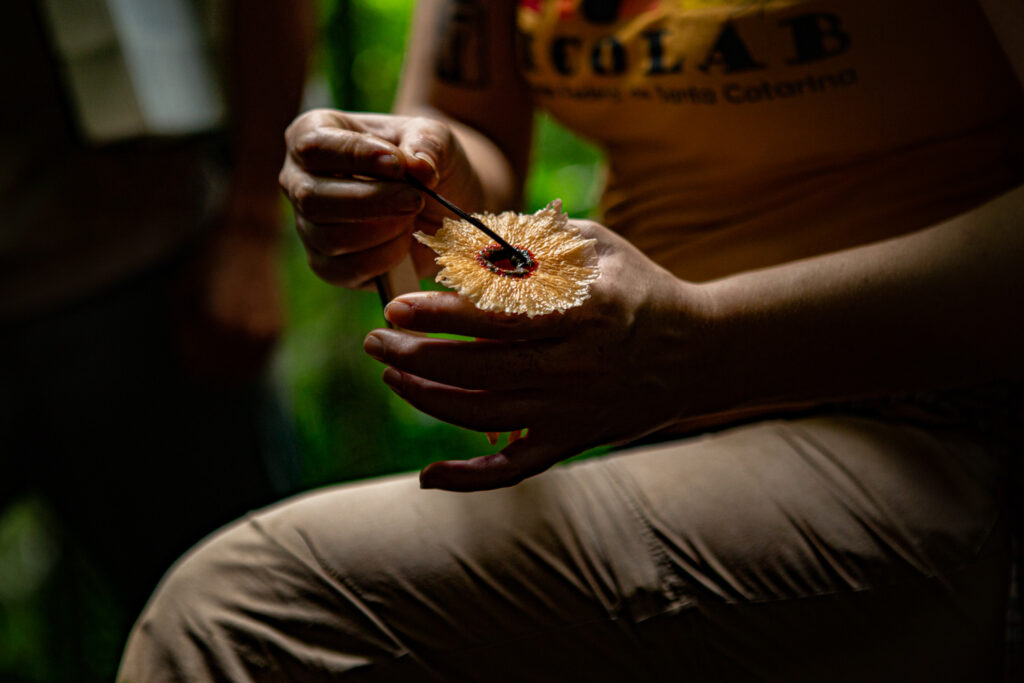As if it were a treasure, it chose a well-protected place to make its abode. A little distant from humans and in an area where the Atlantic Forest is so dense that it forms refuges. There are six strata of treetops, which, like overlapping roofs, form layers of protection. It is one of those shaded and humid environments, where only a few rays of sunlight reach, opening space between the trees and illuminating the dense green.
It was in this environment of shelter and enchantment that Abrachium floriforme revealed itself. So much protection is explained: it is one of those delicate and fragile mushrooms, which careless touch can destroy. And besides, Abrachium floriforme is rare. As far as is known, it is a macrofungus registered only in Brazil, mainly in the northeast.
This makes its appearances at Sítio São José, in Sertão do Taquari, in Paraty (RJ) even more special. Interestingly, when it appeared, it was soon for many people. On three occasions, the Abrachium floriforme emerged for groups of scholars, curious and foragers who participated in the experience of Mushrooms of the Atlantic Forest. “The second time we found the mushroom was very strong for me. I realized that it was not a one-off, it was living there, the mycelia are there”, recalls Jorge Ferreira, the expedition's conductor.

The Abrachium floriforme is a more recently known mushroom. The species was described by a Brazilian researcher, Iuri Baseia, in 2005, in an area of remaining Atlantic Forest in Rio Grande do Norte. At the time, they named the fungus as Aseroë floriformis. Later, in 2012, a morphological and molecular study led by researcher Tiara Sousa Cabral indicated to be a new genus, it was then renamed as Abrachium floriforme.
The work of scientists in the face of a novelty is not simple. “The identification of this group of fungi is very difficult. It is made by the coloring, shape before drying and the structure of the arms”, explains Marcelo Sulzbacher, researcher and educator of edible fungi. Proof of this is that research on the Abrachium still bring news. “A 2021 study led by researcher Gislaine Melanda showed that this species may actually belong to another genus known since 1753, Clathrus, although new collections are still needed to certify this hypothesis”, explains Nelson Menolli Jr., professor and researcher in the field of mycology with a focus on wild edible mushroom species.
Just as its characteristic shape helped its identification, it also guided the choice of its name. the generic name Abrachium means absence of arms, in contrast to other fungi of the same family, which are characterized by having structures similar to open arms. already the floriforme indicates its resemblance to a flower.
And this feature is impossible not to notice. Growing from the ground, rising to the skies and opening to the world, it is like a flower that stands out in the field. The shape resembles that of flowers such as sunflowers or daisies. The upper surface is formed by an intense reddish center surrounded by a delicate lighter part, white, yellow or pink.
The odor of Abrachium floriforme also makes it stand out. The smell is very strong, reminiscent of rotten meat, that is, not pleasant – at least, not for us humans. “It is an attraction for the insects that land looking for meat, then they discover that there is nothing but they leave with the spores on their paws”, explains Marcelo.
All this set of elements so peculiar and attractive, their colors, shape and smell, have their reasons. After all, so hidden in the woods, the Abrachium floriforme it needs to make use of some artifices to make itself noticed and to perpetuate itself. I hope he is lucky in this mission and that more copies of the Abrachium floriforme to color the forest green.


It was amazing to follow this discovery in one of the experiences! 🍄🙏🏻❤️